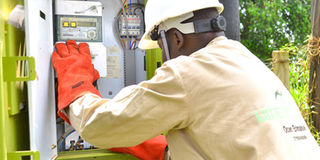Government fails to hit planned electricity connections

Umeme technician at work. FILE PHOTO
What you need to know:
Connections. According to Electricity Regulatory Authority, about 200,000 new connections under the free electricity connections policy have been made since January, but is still below the annual target of 300,000 connections.
Government is approaching 200,000 new connections under the free Electricity Connections Policy (ECP), but is less by 100,000 to hit the 300,000 annual target.
Speaking during the launch of the ‘Pawakapo’ media campaign organised by Electricity Regulatory Authority (ERA), Ms Ziria Tibalwa Waako, the ERA chief executive officer, said nearly 200,000 connections have been made.
“We are approaching 200,000 connections that is the actual connections but we have another 200 applications that we hope to retire by the end of the year,” she said, explaining that 95 per cent of the connections were made by the main power distributor, Umeme.
“We should be able to hit 300,000 or more by the end of the year. Most of them are part of Umeme, out of the 200,000 applications that we are processing 150,000 is attributed to Umeme and the others are distributed across,” she added.
The campaign – Pawakapo – seeks to train and certify wiremen (kamyufu).
Government kicked off the implementation of ECP in August 2018 with an ambitious plan of increasing connections from an average of 80,000 to 300,000 annually.
However, data from Umeme’s half-year results in August 2019 indicated that only 93,580 connections had been made during the period.
The policy has in fact had positive results considering that it faced challenges in the implementation stage.
For instance, there was a challenge of delayed verification of electricity metres by Uganda National Bureau of Standards, which slowed down the connections process. Umeme also successfully argued for the regulator to increase its distribution, maintenance and operations costs on the back of increased connections. However, the process took almost six months.
ERA had approved only half of what Umeme had proposed and said at the time there was not enough justification to allot more money to the power distributor.
The cost of inspection, as well as wiring, was also an underlying challenge to which a world bank grant of Shs18b was awarded to acquire and connect 15,000 households using ready boards.
Ready boards (usually wooden and sometimes metallic) are fixed with sockets, bulb holders and switches on a single panel.
According to Ms Waako, this is only the pilot year of implementation, challenges have been addressed and the future is still very bright.
Electricity Act
The discussion was on the sidelines of the pawakapo campaign which seeks to tame illegal electricity connections propelled by uncertified wire persons - kamyufu - through training and certifying their activities.
To further curb illegal connections and power theft, the Minister of Energy, Irene Muloni revealed that the Electricity Act currently under review is expected to be completed by the first quarter of 2020.
“A lot of consultations have been going on. We are now going to submit to cabinet and once approved, it will move to Parliament for debate and then amend the act such that punitive measures are in place to deter people from illegal connections and vandalism,” she noted.
Most illegal electricity connections, according to ERA, are propagated by uncertified wiremen, who reconnect customers even when they are disconnected for illegal connections or non-payment.


